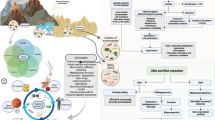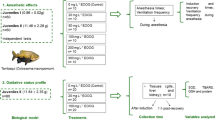Abstract
In hypoxia sensitive cells and tissues, the rates of glucose and O2 consumption are inversely related (Pasteur Effect). Under O2 limiting conditions the demands for glucose (glycogen) in such cells may drastically rise as a means for maintaining ATP turnover close to normoxic rates; nevertheless ion and electrical potentials cannot be sustained due to energy insufficiency and high membrane permeability; metabolic and membrane functions, in effect, are decoupled. ‘Good’ animal anaerobes resolve these problems with a number of biochemical and physiological mechanisms; of these (1) metabolic arrest and (2) stabilized membrane functions are the most effective strategies for extending hypoxia tolerance. Metabolic arrest is achievable by means of a reversed or negative Pasteur Effect (reduced or unchanging glycolytic flux at reduced O2 availability) while coupling of metabolic and membrane function is achievable in spite of the lower energy turnover rates by maintaining membranes of low permeability (probably via reduced densities of ion-specific channels). Although the strategy of combining metabolic arrest with channel arrest has been recognized as a possible intervention, to date success has been minimal, mainly because cold depression of metabolism is the usual arrest mechnism used and this hypothermia in itself perturbs controlled cell function in most endotherms. The only endothermic systems currently known which appear able to use the dual strategy for extending hypoxia tolerance are hypoperfused hypometabolic tissues and organs of diving marine mammals.
Similar content being viewed by others
References
Berridge MJ, Irvine RF (1984) Inositol triphosphate, a novel second messenger in cellular signal transduction. Nature 312:315
Brezis M, Rosen S, Spokes K, Silva P, Epstein FH (1984) Transport-dependent anoxic cell injury in the isolated perfused rate kidney. Am J Pathol 116:327
Else PL (1984) Studies in the evolution of endothermy: mammals from reptiles. PhD Thesis, University of Wollongong, Sydney, NSW Australia
Elsner R, Gooden B (1983) Diving and asphyxia. A comparative study of animals and man. Cambridge University Press, pp 1–168
Guppy M, Hill RD, Schneider RC, Qvist J, Liggins GC, Zapol WM, Hochachka PW (1986) Influence of voluntary diving on Weddell seal metabolism examined by microprocessor controlled blood sampling. Am J Physiol 250:R175
Halasz NA, Elsner R, Garvie RS, Grotke GT (1974) Renal recovery from ischemia: a comparative study of harbor seal and dog kidneys. Am J Physiol 227:1331
Hansen AJ (1985) Effect of anoxia on ion distribution in the brain. Physiol Rev 65:101
Hillie B (1984) Ionic channels of excitable membranes. Sinauer Association, Sunderland, Mass, pp 1–426
Hochachka PW (1982) Metabolic arrest as a mechanism of protection against hypoxia. In: Wauquier A, Borgers M, Amery WK (eds) Protection of tissues against hypoxia. Elsevier Press, Amsterdam, pp 1–12
Hochacka PW (1985) Exercise limitations at high altitude: the metabolic problem and search for its solution. In: Gilles R (ed) Circulation, respiration and metabolism. Springer, Springer, Berlin Heidelberg New York Tokyo
Hochachka PW (1986) Defence strategies against hypoxia and hypothermia. Science 231:234
Hochachka PW, Guppy M (1986) Metabolic arrest and the control of biological time. Harvard University Press, Cambridge, Mass (in press)
Hochachka PW, Mommsen TP (1983) Protons and anaerbiosis. Science 219:1391
Hochachka PW, Somero GN (1984) Biochemical adaptation. Princeton University Press, Princeton NY, p 297–309
Hulbert AJ, Else PL (1981) Comparison of the “mammal machine” and the “reptile machine”: energy used and thyroid activity. Am J Physiol 241:R350
Jackson DC, Heisler N (1983) Intracellular and extracellular acid-base and electrolyte status of submerged anoxic turtles at 3° C. Respir Physiol 53:187
Matthys E, Patel Y, Kreisberg J, Stewart JH, Venkatachalam M (1984) Lipid alterations induced by renal ischemia: pathogenic factor in membrane damage. Kidney Int 26:153
Palmer LG, Li JHY, Lindemann B, Edelman IS (1982) Aldosterone control of the density of sodium channels in toad urinary bladder. J Membrane Biol 64:91
Qvist J, Hill RD, Schneider RC, Falke KJ, Liggins GC, Guppy M, Elliott RL, Hochacka PW, Zapol WM (1986) Hemoglobin concentrations and blood gas tensions of free-diving Weddell seals. J Appl Physiol (in press)
Rubin RP, Weiss GB, Putney JW Jr (eds) (1985) Calcium in biological fluids. Plenum Press, New York, pp 391–490
Scholander P (1940) Experimental investigations on the respiratory function in diving mammals and birds. Hvalradets Skrifter, Norske Videnskap-Akad, Oslo 22, 1–13
Sick TJ, Rosenthal M, LaManna JC, Lutz PL (1982) Brain K+ homeostasis, anoxia, and metabolic inhibition in turtles and rats. Am J Physiol 243:R281
Siesjo BK (1981) Cell damage in the brai: a speculative synthesis. J Cereb Blood Flow Metal 1:155
Stewart PW (1981) How to understand acid-base: a quantitative acid-base primer for biology and medicine. Elsevier. North Holland, New York, pp 1–186
Surlykke A (1983) Effect of anoxia on the nervous system of a facultative anaerobic invertebrate, Arenicola marina. Marine Biol Lett 4:117
Theodore J, Robin ED, Jamieson SW, van Kessell A, Rubin D, Stinson EB, Shumway NE (1985) Impact of profound reductions of PaO2 on O2 transport and utilization in congenital heart disease. Chest 87:293
Zapol WM, Liggins GC, Schneider RC, Qvist J, Snider MT, Creasy RK, Hochachka PW (1979) Regional blood flow during simulated diving in the conscious Weddell seal. J Appl Physiol 47:968
Author information
Authors and Affiliations
Rights and permissions
About this article
Cite this article
Hochachka, P.W. Metabolic arrest. Intensive Care Med 12, 127–133 (1986). https://doi.org/10.1007/BF00254926
Accepted:
Issue Date:
DOI: https://doi.org/10.1007/BF00254926




